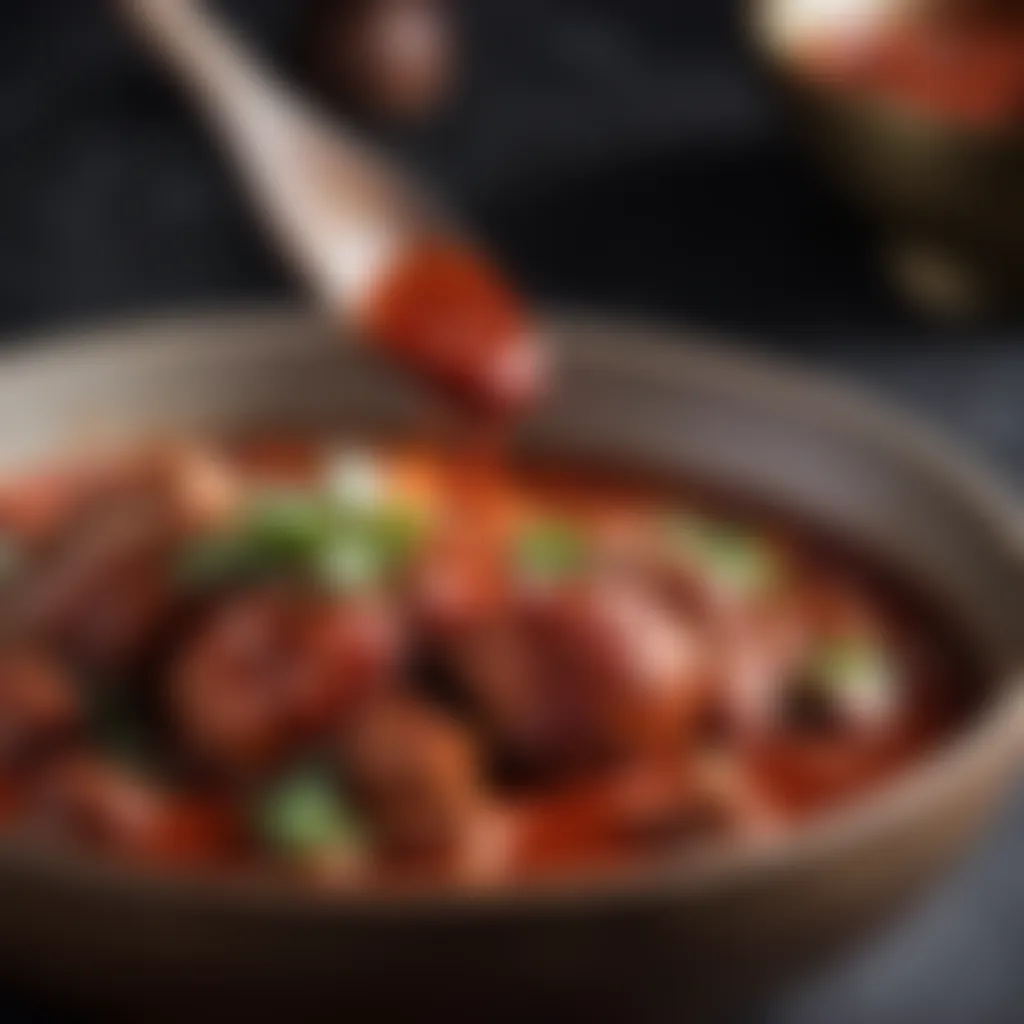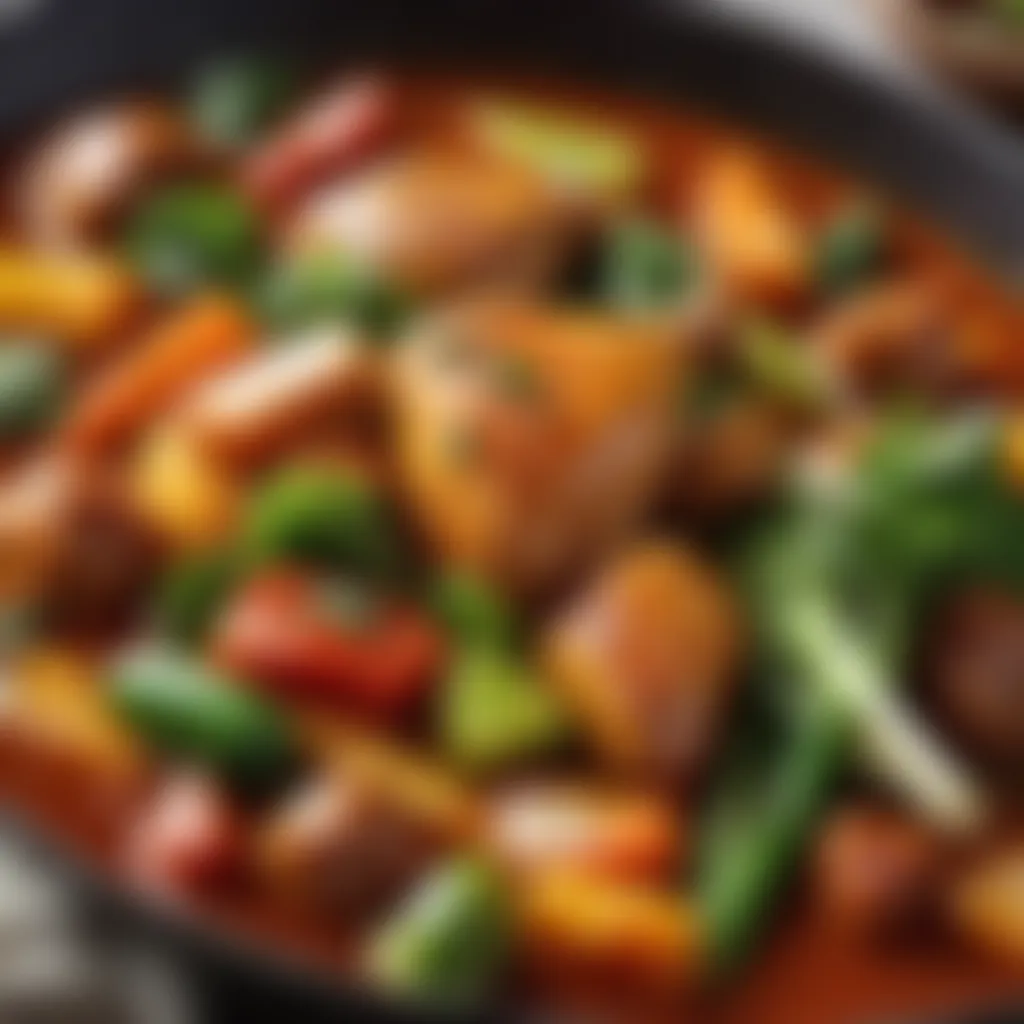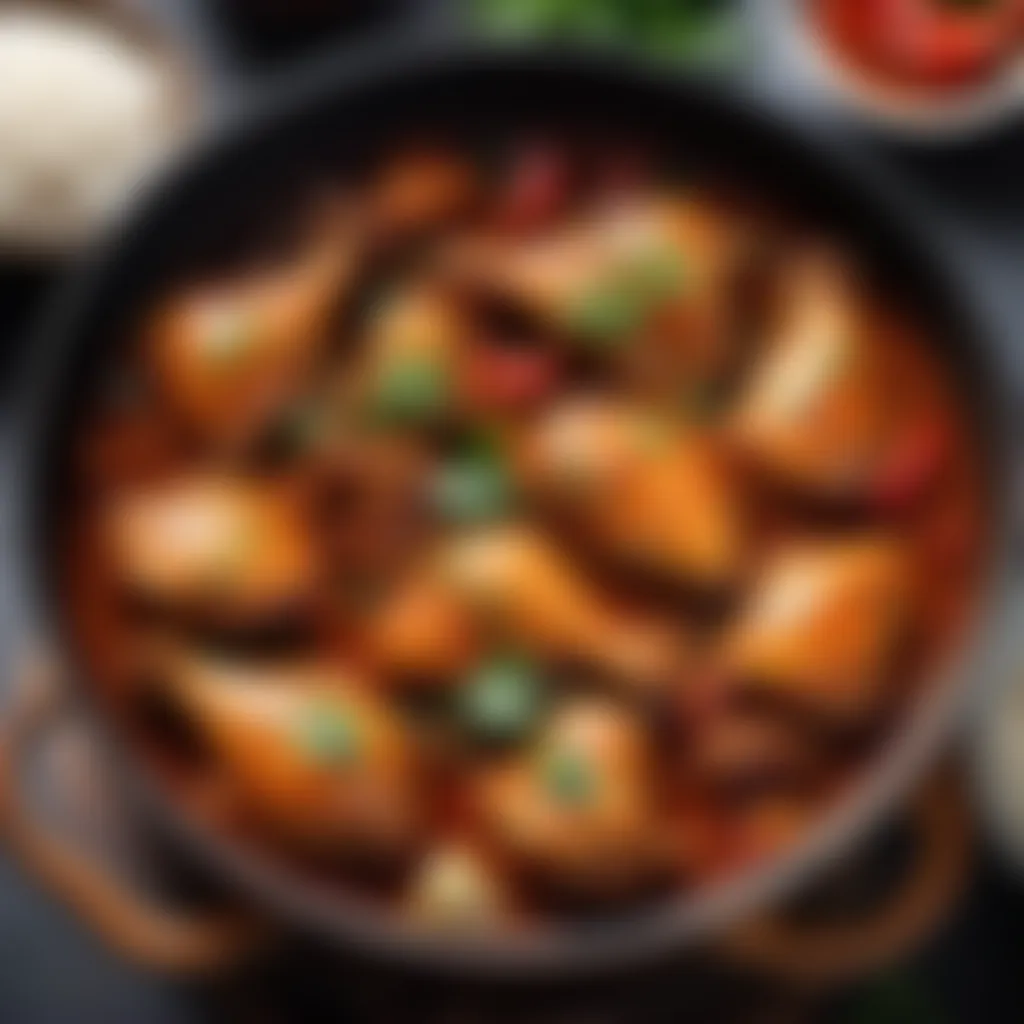The Complete Guide to Dakdoritang: Korean Chicken Stew


Intro
Dakdoritang, with its bold flavors and tender chicken, stands out as one of Korea's cherished culinary delights. This spicy braised chicken stew is not just a meal; it's a celebration of taste and culture that warms both the heart and palate. Originating from the bustling streets and home kitchens of Korea, Dakdoritang is known to unite families over dinner tables and is a popular choice for gatherings.
In this guide, we will unravel the layers of Dakdoritang, exploring its significance in Korean cuisine while also diving into its various interpretations across regions. By the end, you will have a solid grasp of the ingredients needed, the step-by-step preparation, and invaluable tips that will ensure you can replicate this soulful dish in your kitchen with confidence and flair.
Let's roll up our sleeves and get started on this culinary adventure!
Ingredients:
To craft a perfect pot of Dakdoritang, you'll need the following ingredients:
- Chicken (bone-in, skin-on) - 1.5 kg (approximately 3-4 lbs)
- Potato - 2 medium, peeled and cut into large cubes
- Carrot - 1 large, sliced
- Onion - 1 large, quartered
- Green onions - 2 stalks, chopped
- Garlic - 6 cloves, minced
- Ginger - 1-inch piece, minced
- Korean chili paste (gochujang) - 3 tablespoons
- Korean chili flakes (gochugaru) - 2 tablespoons
- Soy sauce - 4 tablespoons
- Water - 4 cups
- Sesame oil - 2 tablespoons
- Sugar - 1 tablespoon
- Black pepper - to taste
"A dish is not just about ingredients; it's about how those ingredients come together in harmony."
Preparation Steps:
When you're ready to create Dakdoritang, don’t rush the process. Follow these detailed instructions carefully:
- Prepare the Chicken: Rinse the chicken pieces under cold water and pat them dry with paper towels. This step helps to remove any impurities and excess moisture, ensuring a better sear during cooking.
- Marinate: In a large bowl, mix gochujang, gochugaru, soy sauce, sugar, minced garlic, minced ginger, and black pepper. Coat the chicken evenly with this marinade and let it sit for about 30 minutes, allowing the flavors to soak in.
- Chop the Vegetables: While the chicken marinates, chop the potatoes, carrot, and onion into large, uniform pieces. This ensures they cook evenly.
- Prep the Cooking Pot: Heat the sesame oil in a large pot or dutch oven over medium-high heat. Once hot, add the marinated chicken skin-side down. Sear for 5 minutes on each side until golden brown.
- Add Vegetables and Liquid: Once seared, toss in the chopped potatoes, carrots, and onions, followed by 4 cups of water. Stir well.
- Bring to a Simmer: Increase heat to high until the pot begins to boil, then reduce to low, cover, and let it simmer. Allow it to cook for about 40 minutes, stirring occasionally. The key is to ensure the chicken becomes tender and the flavors meld beautifully.
- Final Touches: After 40 minutes, incorporate the chopped green onions. Adjust seasoning with more soy sauce or pepper, if necessary.
Technical Aspects:
A few technical details can elevate your cooking:
- Temperature Settings: Maintain heat at a constant low simmer when the pot is covered. This allows gradual cooking without boiling over.
- Timing Specifics: Stick to the 40-minute simmer for getting that melt-in-your-mouth chicken. But, if the chicken is not tender enough, you may want to extend cooking by an additional 10 minutes.
- Critical Techniques: Make sure to brown the chicken well; this step enhances the overall flavor and color of the stew. Also, do not skip the marination; it’s crucial for delivering authentic taste.
Cooking Process:
Here’s a step-by-step breakdown of the cooking method:
- Sear the Chicken: Get a nice, golden-brown crust on your chicken pieces.
- Simmer Consistently: Once the water is added, keep an eye on the simmering. Stir occasionally to prevent sticking.
- Adjust as Necessary: Taste and tweak flavors as the dish cooks. You can add more gochujang for heat or some honey for sweetness if you find it too spicy.
Troubleshooting Tips:
Even seasoned cooks face challenges. Here are solutions to common issues you might encounter:
- Too Spicy? Add extra potatoes and a touch of sugar to balance the heat.
- Not Thick Enough? Remove the lid and let it simmer uncovered for a few minutes to evaporate excess liquid.
- Chicken Drying Out? Ensure you’re cooking it at a low simmer. High heat can toughen the meat.
With these foundational steps and detailed insights, you are well on your way to mastering the art of Dakdoritang.
Foreword to Dakdoritang
Dakdoritang is more than just a dish; it’s a warm embrace on chilly days and a flavorful reminder of home for many. This spicy Korean braised chicken stew carries with it a tapestry of history and culture. In this guide, we will take a dive into the origins of Dakdoritang and explore its significance within Korean cuisine. Understanding this dish, both in its historical context and its cultural meaning, enriches the experience of cooking and enjoying it. You don't just make Dakdoritang; you participate in a tradition, a ritual that connects generations.
Historical Background
The roots of Dakdoritang can be traced back to traditional Korean cooking practices, where the combination of meat and vegetables simmered gently was common. Chicken was often prized for its versatility and flavor, becoming a staple in many households. It was especially favored during festivals and family gatherings, embodying both hospitality and generosity.
Originally, Dakdoritang was a humble dish, meant to be a hearty meal that could feed a crowd. Older recipes might have utilized wild trees or foraged vegetables, lending rustic charms to the dish. As time moved forward, so did the recipe itself. The key flavors of gochugaru and soy sauce became prominent, transforming simple chicken into something exquisite and satisfying. Such evolutions reflect the adaptability of Korean cuisine, which continues to embrace change while holding onto its core ingredients and flavors.
Cultural Significance in Korean Cuisine


Dakdoritang holds a cherished spot in Korean culinary traditions. It is common to find this dish gracing the tables during chilly evenings or family celebrations. The way it brings people together—friends sharing laughter and stories, families gathering for a late-night meal—strengthens its place in the cultural heart of Korea.
Many Korean households consider it a comfort food, akin to what mac and cheese might mean in the West. It not only fills the stomach but invigorates the spirit. People often say that when someone you love cooks you Dakdoritang, it’s more than just food; it's a gesture of care.
Food is a bridge among generations, and Dakdoritang serves as a delicious archway connecting young and old alike.
As you cook Dakdoritang, you are not just preparing a meal but weaving together shared memories, heritage, and identity. Understanding its historical and cultural place allows you to appreciate every bite even more, making your cooking journey richer and more meaningful.
Core Ingredients of Dakdoritang
When it comes to Dakdoritang, the beauty of the dish lies in its core ingredients. Each component contributes not just to the flavor, but also to the overall essence of this spicy stew. Understanding the importance of these ingredients opens the door to a more profound appreciation of the dish. Selecting quality items, knowing their origins, and recognizing their culinary roles transforms cooking Dakdoritang from mere preparation to an art form.
Primary Components
At its heart, Dakdoritang features chicken as the star ingredient. Typically, skin-on, bone-in parts are preferred because they provide richer flavor and tenderness. Thighs are a popular choice, offering a balance of meatiness and fat that keeps the stew succulent.
Alongside the chicken, another key component is the braising liquid, a delightful infusion of spices, soy sauce, and sugar. This mixture melds with the chicken, creating a sauce that’s both savory and slightly sweet.
Spices and Seasonings
The magic of Dakdoritang can be attributed to its vibrant spices. Gochugaru, or Korean red pepper flakes, stands out as the primary spice. This pepper lends the dish its characteristic heat without overwhelming. A blend of soy sauce and garlic adds depth, while ginger brings warmth. The subtle sweetness often comes from sprinkling in some sugar or honey, which harmonizes the spiciness and helps to achieve that alluring glaze.
Whether it’s a dash or a handful, the right amount of spice can elevate the stew from ordinary to memorable.
Vegetables Used
Vegetables also play a pivotal role in enhancing the stew's flavor profile. Potatoes are often a staple, offering a creamy texture once cooked. Carrots, sliced into rounds, introduce a touch of sweetness that balances the spices. Onions—be they yellow or green—infuse the dish with savoriness, becoming tender and almost caramelized through the cooking process.
Furthermore, adding mushrooms, like shiitake or enoki, introduces earthiness, contributing to the overall complexity of the stew.
Types of Chicken
While Dakdoritang predominantly calls for common chicken cuts, some cooks opt for variations. Free-range chicken tends to have a deeper flavor due to its diet and lifestyle. Alternatively, using cut-up whole chickens allows for a mix of textures, as the dark meat from thighs and the light meat from breasts cook differently, resulting in a more diverse mouthfeel.
In some regions, even duck is used, adding an extra layer of richness to the stew, but chicken remains the comfort of choice for most households.
Understanding these core ingredients connects cooks to the heart of Dakdoritang. Not only do these elements work in harmony to create flavor, but they also mirror the tradition and culture behind this beloved Korean dish.
Preparation Methods
The preparation methods used in crafting Dakdoritang are crucial to achieving the rich, savory flavor profile that distinguishes this dish. The art of preparing this stew is not just about throwing ingredients into a pot; it's a dance of techniques that work together to weave intricate flavors. The selection of the right methods can greatly elevate the culinary experience, making the dish not only delicious but also visually appealing.
Marinating the Chicken
Marinating the chicken is where the magic begins. This step allows the chicken to soak up all the flavors from the marinade, which typically includes gochujang, soy sauce, garlic, and other aromatic spices. The longer you marinade, the deeper the flavor penetrates. You might want to consider marinating overnight, as this gives the ingredients time to mingle and create a well-rounded taste.
A well-marinated chicken absorbs these flavors, turning an ordinary piece of poultry into a succulent part of the dish. The texture transforms as well, making it juicy and tender once cooked. On the practical side, marinating is also a great way to engage your senses, as the aroma from marinated chicken fills the kitchen, tantalizing everyone who’s nearby.
Cooking Techniques
Braising
Braising is a technique that involves cooking the chicken slowly in a liquid, allowing it to gradually absorb flavors while becoming exquisitely tender. This method is exceptional for developing depth in the stew. Essentially, you start by searing the chicken to lock in the juices and then let it simmer in the flavorful broth.


The key characteristic of braising is its slow and steady cooking process. This method allows the collagen in the chicken to break down, resulting in a melt-in-your-mouth consistency. One of the unique features of braising is that it often uses a combination of dry and wet heat, giving each bite a rich, complex flavor.
While braising is a beneficial choice for Dakdoritang, one must consider time management as it requires patience. However, the reward for spending time on this method is a stew that can only be described as comfort in a bowl.
Simmering
Simmering is another vital technique that is often employed in the preparation of Dakdoritang. This method is about keeping the liquid at a gentle boil, allowing the ingredients to marry together in harmony. Simmering ensures the chicken is thoroughly cooked and coated in that delicious spicy sauce without losing all moisture.
A key characteristic of simmering is that it maintains a lower temperature, so ingredients don’t break down too quickly. This is a beneficial method because it allows flavors to develop while keeping the chicken intact. One unique feature is its simplicity; once everything is in the pot, you can step away for a while without constant stirring.
However, keep in mind that simmering for too long may lead to a less satisfying texture, as the chicken could become overly soft. Finding that right balance between simmering time and achieving flavor is paramount.
Adjusting Spice Levels
When it comes to Dakdoritang, adjusting the spice levels is an art form in itself. Different palates call for different levels of heat, and providing the right balance can make or break the dish. For those who prefer milder flavors, reducing the amount of gochugaru or adding more vegetables can tone down the heat.
Conversely, if you desire an extra kick, ramping up the gochujang might just do the trick. You can also introduce some fresh chili peppers to the mix for an additional punch. The beauty lies in the ability to cater to personal preferences while staying true to the authentic flavors of this cherished stew.
*
Adjusting spices can significantly shift your Dakdoritang experience, as the richness of flavors comes not just from the heat but also from the harmonization of all the ingredients.
Regional Variations
The beauty of Dakdoritang isn’t just in its ingredients or methods; it's intricately tied to the regions where it’s made. Understanding the regional variations of this vibrant stew is essential. It shows how local ingredients, climate, and cultural history shape its flavor and presentation. Exploring these variations offers insights into the unique culinary identities in Korea, helping home cooks appreciate the nuances that set each style apart. The regional distinctions also provide a plethora of options for those who love to experiment, ensuring that every bowl can tell a story of its origins while delighting the taste buds in unexpected ways.
Seoul Style
In the bustling capital of South Korea, Seoul’s version of Dakdoritang is known for its rich flavor profile, balancing heat and subtle sweetness. Seoul-style Dakdoritang uses gochujang, which is a fermented red chili paste, alongside doenjang, a fermented soybean paste. It’s more than just ingredients; the way they come together creates something truly special. Typically, the chicken is cut into larger chunks, letting them soak in the thick, spicy sauce.
An interesting twist is that Seoul's version often incorporates rice cakes, giving it a chewy texture that complements the tender chicken marvelously. The stew is usually simmered for longer, allowing the ingredients to mingle and fully develop the depth of flavor that is characteristic of the city’s culinary scene.
Busan Style
Busan, known for its coastal delights, has a distinctly different flavor approach to Dakdoritang. Here, seafood often finds its way into the pot, reflecting the region’s rich maritime culture. Busan-style Dakdoritang includes fresh fish or mussels, lending an umami depth that’s unexpected but delightful.
Moreover, the spice level tends to be adjusted to suit lighter seafood, making it less fiery than its Seoul counterpart. Instead, korean radish, or mu, plays a crucial role, absorbing the broth's flavors while maintaining a refreshing crunch. This version is perfect for those who enjoy a lighter yet still spicy dish that warms the heart, perfect for cloudy seaside days.
Jeolla Province Influence
In Jeolla Province, regarded as the culinary heartland of Korea, Dakdoritang is celebrated for its emphasis on fresh local produce and a more subtle approach to seasoning. Here, chefs often focus on harmony rather than heat, creating a dish that is well-balanced and vibrant.
This version frequently incorporates seasonal vegetables like spinach, green onions and chard, emphasizing freshness over a strong spice kick. Notably, Jeolla's Dakdoritang might also rely on various side dishes known as banchan, offering a palette of flavors that enhances the dining experience. Jeolla's influence showcases how the dish can adapt to seasonal changes, making it a reflection of the region’s agricultural bounty.
Every region tells a story through its Dakdoritang, allowing each cook to share a piece of home with every bowl.
Nutritional Aspects
Understanding the nutritional aspects of Dakdoritang not only enriches the cooking experience but also highlights the health benefits that can be derived from this dish. Korean cuisine often balances flavor with nutrition, and Dakdoritang stands as a prime example. This stew is packed with protein, essential vitamins, and minerals, making it a viable choice for those who wish to enjoy a wholesome meal. By diving into caloric content, considerations during different life stages, and dietary restrictions, a clearer picture emerges about how to appreciate this culinary delight consciously.
Caloric Content
When preparing Dakdoritang, it’s essential to consider its caloric content. On average, a serving of Dakdoritang can range from 300 to 600 calories, depending on the ingredients and portion sizes used. The chicken, a primary ingredient, contributes significantly to the protein value, while the various vegetables add negligible calories but high-volume satisfaction.


A hearty bowl of Dakdoritang can offer enough nutrients without sailing over the daily caloric limits for most adults.
For those keeping a close eye on their caloric intake, controlling the amount of oil and the type of chicken can make a visible difference. Using skinless chicken breasts usually draws down the calories while keeping the high protein factor intact. Opting for a balanced approach in serving sizes allows one to enjoy the stew's rich flavors without feeling guilty.
Menstrual Cycle Considerations
Women may find Dakdoritang helpful during their menstrual cycles. The iron-rich chicken, along with nutrient-dense vegetables, can help combat fatigue often associated with menstruation. Iron plays a crucial role in replenishing lost blood, and dishes high in protein and vitamins can help maintain energy levels and mood stability.
Additionally, incorporating ingredients like ginger can be beneficial during this time, as it has been shown to alleviate menstrual discomfort for some. The warmth of the stew nurtures the body, offering both comfort and sustenance.
Dietary Restrictions
Dietary restrictions, whether due to health issues or lifestyle choices, should always be factored into meal preparations, including Dakdoritang.
Gluten-Free Options
For those avoiding gluten, Dakdoritang can be easily adapted. The essence of this dish comes from the spices, chicken, and vegetables, all of which are naturally gluten-free. However, soy sauce—which is often included in recipes—can contain gluten unless specified as gluten-free.
Utilizing certified gluten-free soy sauce ensures that individuals with celiac disease or gluten intolerance can enjoy this dish without worry. This adaptability is a key characteristic of Dakdoritang, allowing it to fit various dietary needs while retaining its core flavors.
Substitutes for Spicy Ingredients
Spiciness is a hallmark of Dakdoritang, but those sensitive to heat can opt for substitutes. Instead of the traditional Korean red pepper paste, sweet chili sauce or even crushed tomatoes could be used, offering a milder flavor but still contributing to the overall richness.
This unique feature of flexibility in spice levels ensures that anyone, irrespective of their spice tolerance, can enjoy the stew. Customizing heat not only allows for a personal touch but caters to varying palates, which is essential in a shared dining experience.
Serving Suggestions
When indulging in a bowl of Dakdoritang, how you serve it can truly elevate the experience. This section explores the vital elements of serving suggestions, highlighting ways to enhance flavor, nourish the body, and bring a delightful balance to the meal. When you get the presentation and accompaniments just right, it transforms the dish from simply a meal to a culinary celebration.
Accompaniments and Side Dishes
Side dishes, or banchan, are more than mere accompaniments in Korean dining; they’re essential players on the table. Each bite of Dakdoritang pairs beautifully with selections that complement its robust flavors. Here are some popular banchan that can accompany your stew:
- Kimchi: This fermented staple adds a tangy crunch that counters the stew's heat.
- Pickled Radish: Crisp and refreshing, it offers a bright contrast to the rich, spicy chicken.
- Stir-Fried Vegetables: Simple stir-fries using seasonal veggies add color and nutrition to your plate.
- Bean Sprouts: Lightly seasoned bean sprouts can provide a delightful crunch and subtle earthiness.
Accompanying the stew with varied textures and flavors ensures that your meal isn’t one-dimensional. Each side dish not only balances out the heat but also shows respect for the wide array of tastes present in Korean cuisine.
Pairing with Rice and Banchan
Rice is the backbone of many Korean meals, and with Dakdoritang, it becomes even more crucial. The rice acts as a canvas, soaking in the stew's tantalizing sauce, making each mouthful irresistible. Here are a few tips for optimal pairing:
- Choose the Right Rice: Opt for short-grain or medium-grain rice, as its sticky texture allows it to cling to the bold flavors of Dakdoritang more effectively.
- Portioning: Serving a generous scoop of rice alongside your stew is recommended. It’s common to mix the rice into the stew to create a harmonious blend of flavors.
- Banchan Balance: Consider how side dishes enhance your meal. Light and crunchy banchan will counterbalance the stew's richness, so a colorful array can delight the palate beautifully.
A thoughtful presentation and combination of rice and side dishes can turn an ordinary dinner into an extraordinary experience, allowing every person at the table to savor the full depth of Dakdoritang. This rewarding meal not only nourishes but also nurtures connections, as it’s often shared in joyful gatherings.
Finale
The conclusion of this guide shines a light on the lasting affection for Dakdoritang in Korean culture and its appeal to many around the world. It’s not merely a dish; it encapsulates a story, a tradition, a shared experience in neighborhoods and homes. From cozy family dinners to festive gatherings, Dakdoritang resonates deeply with those who savor its unique flavor profile and the warmth it brings.
The Enduring Appeal of Dakdoritang
"Food is a universal language, and varieties like Dakdoritang speak volumes about culture, comfort, and togetherness."
Dakdoritang’s charm is multi-faceted. First and foremost, its spicy kick captivates those who enjoy robust flavors. However, it is the fusion of tender chicken, rich sauces, and carefully chosen aromatics that truly sets it apart. The meticulous preparation, where every ingredient plays a crucial role, reflects a sense of respect for culinary artistry.
Moreover, the cultural significance cannot be underestimated. In many families, Dakdoritang is a dish that brings people together. It’s common to see generations bonded over a steaming bowl, sharing stories while savoring each bite. This bond is crucial; it fosters not just nourishment but connection.
Additionally, its versatility makes Dakdoritang appealing to a broader audience. Think of how it can be altered to accommodate various dietary needs—from using alternative proteins for non-chicken options to adjusting spice levels for more delicate palates. Such adaptability demonstrates not just the dish's culinary depth but its embrace of diversity.
In summary, Dakdoritang isn’t just a meal; it’s a celebration of Korean culture, a versatile dish that welcomes every palate, and a source of joy for many families. As you explore its flavors, remember that each bowl tells a tale of tradition, togetherness, and respect for the craft of cooking.







